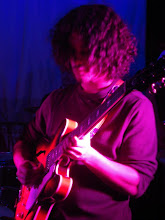There are two things that make developing compound lines on the guitar easier than on other instruments. Especially sequenced compound lines. The first, is that while as guitarists we may generally not have the same control over the decay and sustain of our notes as other instruments (noted exception), we do have a tremendous amount of control over the articulation of our attack. A sensitive execution in terms of individual note volume can really bring a line to life.
If a lot of your experience involving the kinds of lines I'm referring to come mainly from bop heads and Bach inventions then you've probably felt that the guitar is not well suited for this kind of line formation or improvisation. While I've spent a lot of time writing about how to unlock the intervalic possibilities of the guitar, as has this brilliant man, and any decent and popular jazz guitarist today makes use of some sort of contrapuntal or angular and disjointed approach to melody, this notion of compound melody is one worth investigating more closely.
This brings me to the second things that make the guitar a well suited instrument for this kind of melodic exploration. Two many guitarists, myself and my work in these blogs included, tend to become very vertical when they start to explore more interesting intervals melodically. This definitely has its advantages and welcome outcomes and I don't want to seem dismissive about this approach. It's just not what this column is about. As jazz players, we could learn a lot from sitar players and the tapping of metal guitarists in terms of how to unlock the possibilities inherent in the layout of the guitar and take advantage of the obvious fact that the guitar has six strings.
I've sometimes talked about escape lines instead of escape tones, about how once you've learned to delay a resolution, you can postpone it indefinitely so long as you keep enough concentration to remember your intention. Take a look:
I've included video so I don't have to mark fingerings and positions, and here's what to look for.
The first system is a simple demonstration of the idea that you can delay your resolutions by much more than an eighth note without losing its coherence or effect. First there is a simple line and then the line again with a little melodic embellishment of the escape tone.
The second system shows a line a bit more complex, with a hanging dissonance at the top and the bottom of the line. Notice how each of the dissonances is created and resolved on the same string. Using this as a device can allow you to keep track of a complex idea much more easily. It's a way to keep things organized so you don't get lost in the infinite possibilities of sliding your hand around the neck.
The third system is just a neat line that uses a more interesting contrapuntal texture as a resolution.
The fourth system onward are simple exercises which can help you get into this mode of thinking. Hopefully you can fill in the blanks because I've implied more than I've explained in this article but I'm starting to enjoy that much more these days. I've spent a lot of time writing about how to take an exercise like that and extrapolate from it whatever you need to accomplish your goals at a given moment in time. Good luck!
Saturday, November 13, 2010
Subscribe to:
Posts (Atom)

